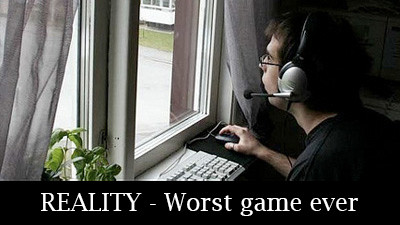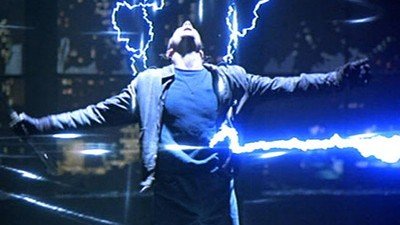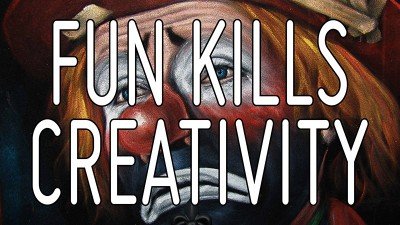Old Grumpy Designer Syndrome
This article was initially published on gamasutra.com on May 30th, 2012.

You’ve done it all. You’ve moved up through the ranks of associate and junior designer, you have been through crunch to ship games, you’ve mastered the internal tools, pioneered new pipelines and techniques and trained other designers to use them. But now you are tired of waiting for that promotion to senior level and lead positions, it is getting on your nerves and it is starting to get old.
Or maybe you are a manager, lead designer, producer or HR rep., and you don’t understand why that highly skilled and very promising designer turned into a negativity beast. You know he’s good but you are at a loss to turn him back to the path of success and create the team pillar that you need.
Having been myself on both sides of this potential career dead-end, I want to share with you my recent study on what I called “The Old Grumpy Designer syndrome”.
OGD syndrome symptoms
An Old Grumpy Designer is generally quite experienced, has developed know-how and has achieved some status for it, owning some part of the tools or processes and being a reference on them. The problem is that instead of using this recognized knowledge to help the team and project move forward, he’s constantly showing how wrong others are and how doomed their efforts.
You’ll often find that the ideas the OGD is most likely to devote his knowledge and energy to burn down, are ideas that are not his, or that challenge what he has established himself. He has become resistant to change and evolution, he just doesn’t want to have to learn new tricks or to reconsider his current ones and he will do everything he can to prevent that from happening.
 Not only is the team wasting valuable energy and insight interacting with him, but as long this toxic behaviour persists unchecked, creativity gradually goes down, as it can only exist in a positive environment where ideas are nurtured instead of shut out. A failing creative dynamic within a team is definitely a sign that should ring a bell and trigger further investigation.
Not only is the team wasting valuable energy and insight interacting with him, but as long this toxic behaviour persists unchecked, creativity gradually goes down, as it can only exist in a positive environment where ideas are nurtured instead of shut out. A failing creative dynamic within a team is definitely a sign that should ring a bell and trigger further investigation.
Another trait that can appear in an OGD is extreme ambition that is disconnected from the realities of your project. An OGD can compare the current sprint with the actual end-results achieved by the reference blockbuster game and develop negativity as a result. They might think they need to win the Super Bowl in one play and get paralyzed from it, when all is asked is to gain a few yards.
The last frequent trait of ODGs is that they consistently ask for a higher position, either for a senior rank or lead. Because of their experience and skills, this is a perfectly valid progression, but as these designers usually don’t get promoted because of their attitude, it leads to a frustration build-up that of course worsens the other symptoms.
Establishing a diagnosis
When trying to identify if you are facing an OGD, it is important to look for the symptoms discussed earlier. Study the way a designer communicates with his peers, gives feedback and proposals. Generally, a grumpy designer will be trigger happy with the reply-all button and tend to be quite present in mail threads and flame wars. Brainstorms or group discussions are also opportunities to notice a tendency to shut down others’ ideas and try to impose his own.
Another thing to look for is career dynamic. Has the designer been at his level for some time now or has he been stuck for too long in the past? It is only natural that stagnating at a given level is bound to create a perpetual bad mood and can be a catalyst for the other issues, especially if no adapted growth path has been offered.
Ultimately, browsing all archived performance reviews is going to give perspective and help monitor the apparition and evolution of many of the issues that have most probably been already recorded and communicated to the grumpy designer. Often you will see a discrepancy between the self-evaluation scores and the marks given by the manager. I have found that this is often ignored, especially if the overall appreciation is that the designer gives satisfaction, but it is actually important to discuss the reason behind the divergence of opinion. I witnessed a case where a designer received high marks and was noted as exceeding expectation, his self-evaluation, though, was even higher than this. This shows that the praise is not perceived and this can lead to a dangerous and unnecessary self one-upmanship that will actually hamper designer performance and progression.
Of course, if this situation has been going on for too long and the same problems keep appearing in the report, you generally see the overall performance go down, sometimes to critical levels.
Treating the syndrome
 So you think you’ve got an OGD. You now realize that one of your beloved designers in which you’ve put so much hope and given key tasks to is actually responsible for a drop in productivity within the team, bad mood and a general feeling that everyone is afraid to speak up. The consequence may be mild, but the bottom line is that things could be way better than they are if this designer turned his negative behaviour into an uplifting collaborative attitude and put his skills forward to help everyone.
So you think you’ve got an OGD. You now realize that one of your beloved designers in which you’ve put so much hope and given key tasks to is actually responsible for a drop in productivity within the team, bad mood and a general feeling that everyone is afraid to speak up. The consequence may be mild, but the bottom line is that things could be way better than they are if this designer turned his negative behaviour into an uplifting collaborative attitude and put his skills forward to help everyone.
First you need to do your homework, go back to all the symptoms you’ve noticed and write them down. Dig up the repeated mentions you’ve found in the performance reviews, list the emails or discussion outbreaks, run stats on how often personal evaluations were higher than those of his manager. Make sure you compile all the elements that demonstrate a problem. You’ll need a substantial round of bullets going into this because that’s how you’ll put your grumpy designer off-balance and bring down his mental fortress so he sees it from your perspective.
Book a one-on-one meeting and explain the situation, point out how it doesn’t live up to your expectations and try to have your grumpy designer acknowledge that he has a part in it. You will see him resist, argue and redirect the discussion to his successes, put the blame on external factors and so on. That is where your preparation should pay off. With concrete examples coming from different sources and different time periods, you should be able to get to him.
The main idea is to keep things positive though. The message that needs to come across is: “Yes, we know you are good and have skills, we recognize that and it’s the reason you’ve made it this far. Now, you are stuck in a behavior that holds you back and is toxic to the team, let’s work that out.” Having him realize that he has a negative impact on his teammates plays a big part in shaking the OGD out of it. I’ve seen several of them respond to the idea that they were hurting other people that they work with. “I don’t want to be toxic”, they’ll frequently say.
I don’t want to be toxic.
It is a delicate discussion to have and it can become quite heated and hard to get your point across, but it also can get pretty personal and emotional to receive such critical feedback, so be ready for a ride. I believe it is best to separate this effort from the official performance reviews so as to reduce the tension that comes with those formal processes and instead make it clear that this is a personal development initiative aimed at helping the designer out of a career pitfall and back on track. That is also why you don’t want to rush it. It is natural for them to resist what can be perceived as criticism and you might want to adjourn the session, let the feedback sink in and start the discussion afresh a few days later.
From my experience, a mix of preparation, good will and humor can get you through that process and secure incredible results. To my amazement, I have witnessed complete turnaround in a matter of days. The passion that defines people in the video game industry tends to amplify behaviours and reactions. Fail to provide proper direction and purpose, and you will witness confusion between consuming content as a player and creating content as a designer, in addition to personal focus instead of teamwork. Truth is that if you motivate our genetically engrained tendency to perform for the betterment of the group, you will see passion take over and turn OGDs into key players in your team within moments.
After having explained to designers that it served no purpose to keep grumbling about how the project will never truly compete with the game they respected so much when all that was asked from them was to do their best within existing constrains, arguments quickly stopped within the team. The very next day, their lead saw one of them pop his head away from his screen and say to him: “It feels so good just being professional!” and went on to blast through the tasks at hand. The very next day…
It feels so good just being professional!
Change can take some time though, and I recommend booking follow-up sessions to acknowledge the improvements and the areas that still could improve over time.
Preventing the syndrome
I think that the root cause of the syndrome is a widely spread problem: low self-esteem. As detailed in my previous article, design is poorly defined and understood which even makes experienced designers feel like they need to protect their “phoney baloney jobs” and tends to makes them defensive. With the awkward task of “coming up with the fun,” limited authority, unclear processes, and inefficient metrics for success, it is understandable that with rising stakes, the OGD will resort to bringing people down around him, in a desperate attempt to shine by comparison.
Although it is on the designer to control his own grumpiness level, I believe that the responsibility lies with his manager and the company structure to provide the right environment to grow in as well as give timely feedback to adjust his behavior. It is safe to say that designers aren’t generally great managers, thus I would recommend that producing staff and HR assist and advise the lead designer facing a case of OGD in his team. Of course, it’s even better if you have a Design Director at studio level, as he can help designers grow without the pressure that comes with direct supervision.
But I also think that there are structural reasons that make the job of a designer quite difficult. The biggest offender being that elusive notion of “fun” that is so poorly defined that it ends up being very subjectively evaluated, if at all. It puts huge pressure on the designers while stripping them of much needed autonomy and sense of competency. Teams need to at least acknowledge that fun is by (lack of) definition hard to come up with and implement an extended conception phase to identify the desired modalities of fun and prototype its essence before the massive gears of production start spinning.
A better structure that recognizes the different specialties of design can also make the best of each designer. Looking at programming, which is actually explicitly segmented by functional role, like 3D engineering, AI or tools, you will also see positions that correspond to different levels of abstraction, like architect or manager. Art also brings a great top-down hierarchy between artistic vision, concept art and actual asset building. Furthermore, it incorporates critique as an established part of the creative process, which resonates with programming’s code review. Designers, on the other hand, are often … well … designers, a poorly defined title that doesn’t offer clear career paths.
Ultimately, I believe that the confusion between design and creative vision hurts projects immensely. Just like film studios need a director and a team of specialists of each field to make a movie, design and creative vision should be separated. All disciplines should become technical providers of solutions to support the vision and make it exist in the game. Putting design in charge of the vision leads to confusion between the means and the end and creates an unfair and unstable situation. Lastly, diluting the responsibility of vision between design, art and programming, this typically leads each to develop their own independent vision, and creates an unfocused experience.
Conclusion
I want to take the opportunity to thank the designers that remained good sports even though I was calling them old and grumpy. They showed a great lot of maturity and fortitude exploring that syndrome with me and I know first-hand that it made a difference for them. I also want to personally apologize to the colleagues I have been toxic to in my career, the pain I caused was uncalled-for and I am sorry for it.
What I detailed here may seem like basic management techniques and they probably are, but this article represents an effort I have very rarely seen done in the field of design. It is two-fold and should be taken from both the angle of the designers themselves and also from the perspective of studio structure. After all, our industry has been around for only about 30 years and even though its growth has been incredibly fast, we must remain on the lookout for improvements to our creative processes and theories, as they are still, on many accounts, not fully matured.
So please, if you are an experienced designer, don’t fall prey to complacency and try to be open to new ideas even if they go contrary to what got your past successes, and if you are a manager, be on the lookout for improvements in your processes to understand, shepherd and improve creativity.
Other articles you might like:
Article: Design your team like you would a game
The same principles that games use to keep players engaged can be applied to structure a team to feel engaged and safe to be creative.
Article: Lifting the designer's curse
We need to better understand and support game designers in their work, or the whole project will fall apart.
Video: Fun kills creativity
Fun is a dangerous word to use in a creative environment.






Very well written and also very useful. Thanks Alexandre!